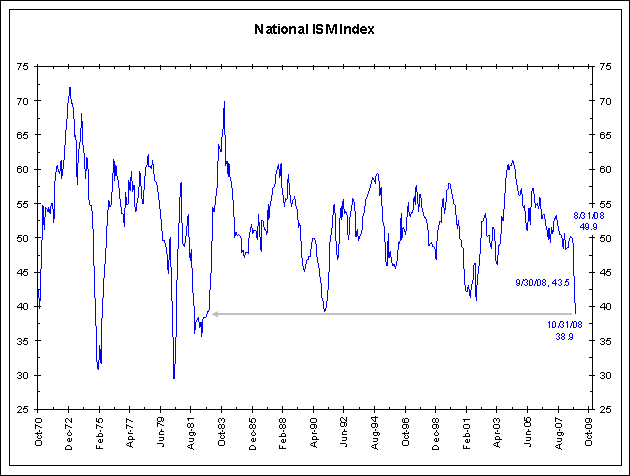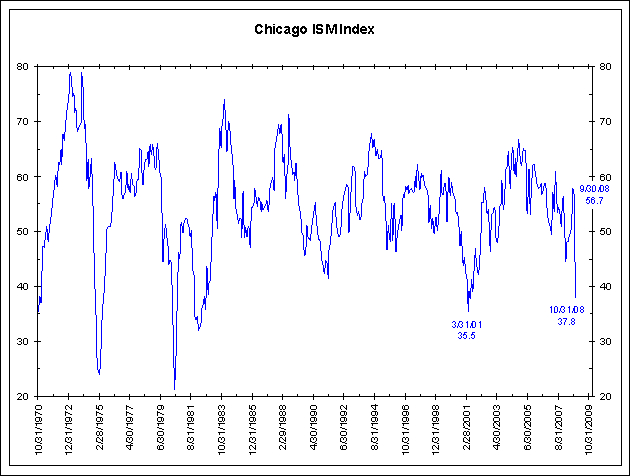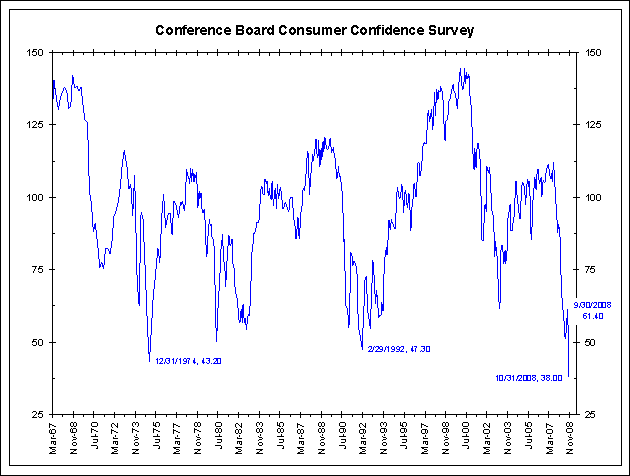-
Bloomberg.com – U.S. Auto Sales Fall 32% to Lowest Total in 17 Years
U.S. auto sales plummeted 32 percent in October to the lowest monthly total since January 1991, led by General Motors Corp.‘s 45 percent slide, as reduced access to loans and a weaker economy kept consumers off dealer lots. Ford Motor Co. reported a 30 percent drop in car and light- truck sales from a year earlier and Toyota Motor Corp.’s declined 23 percent. Honda Motor Co.’s slid 25 percent, Nissan Motor Co.’s were down 33 percent and Chrysler LLC’s fell 35 percent. `If you adjust for population growth, it’s the worst sales month in the post-World War II era” for the industry, said Mike DiGiovanni, GM’s chief sales analyst, on a conference call. “Clearly we’re in a dire situation.” Industrywide U.S. auto sales fell for the 12th straight month, extending the longest slide in 17 years. Tight credit, falling consumer confidence and the weakening economy, the same forces that suppressed buying in September, hurt automakers again last month.

<Click on chart for larger image>
-
MarketBeat (WSJ Blog) – Four at Four: Frozen Cars, Falling From the Sky
“Businesses are putting freezes on, and it has frozen all economic behavior, as if you froze a plane at 20,000 feet and it’s fallen to 10,000 feet.” Certainly the shares of Ford and GM resemble such a happening. GM lost 2.3% and Ford was down 2.7% Monday, and J.P. Morgan Chase analyst described the GM conference call as “dour,” noting that management was calling on banks and government to “assist the industry by taking steps to unfreeze the credit markets.” The thing is, looking at the Fed’s balance sheet, the monetary authorities are attempting to unfreeze these markets, but it still does not mean anyone wants to purchase anything. “It’s not that we need lower rates, but to convince the banks that rates reflect lower credit risk,” says Mr. Paulsen. It’s an uphill battle, one not likely to be accomplished behind the wheel of Ford or GM. -
Bloomberg.com – U.S. Economy: Factory Index Declines to 26-Year Low
Manufacturing in the U.S. contracted in October at the fastest pace in 26 years as a record share of banks made it tougher to get loans and faltering economies abroad eroded prospects for American exports. The Institute for Supply Management’s factory index fell to 38.9 from 43.5 in September; 50 is the dividing line between expansion and contraction. The Commerce Department said separately that construction spending fell for the eighth time in 10 months in September. Today’s report may add to pressure for further interest-rate cuts and an additional federal package of tax and spending measures. The figures also showed the weakest level for U.S. export orders in the two decades the ISM has kept the data, a sign of slowdowns in Europe and Asia.

<Click on chart for larger image>

<Click on chart for larger image>
-
Bloomberg.com – New York Commercial Property Sales Plunge 61% in Credit Freeze
New York City commercial real estate transactions plunged 61 percent in 2008 through October as the global credit crisis roiled lending and sidelined buyers. About $17 billion of transactions have closed so far and the market is headed for its worst year since 2004, according to data from Real Capital Analytics Inc. of New York. Sellers have made 237 deals of $5 million or more, a four-year low in a market that posted a record $51 billion in sales in 2007. “The banks are not lending, and most of them are saying we’re done for the year,” said Scott Latham, executive vice president for New York investment sales at Cushman & Wakefield Inc., the largest closely held commercial brokerage. “In all likelihood, you will see next to no transactions between now and the end of the year.”
Comment Anecdotal evidence says that economic activity stopped on Friday, October 10. This was the end of a week in which the Dow Jones Industrial Average lost 3,000 points for its worst percentage loss in 75 years. It was also the week after the TARP was passed, the plan that was supposed to prevent this exact kind of collapse.
Until a few days ago talk of the economy stopping (or “freezing” as described above) was just that – talk. There were no economic statistics for October to confirm or deny it. In the last few days, however, October economic statistics have been trickling out and what it shows is not good.
-
First out was October consumer confidence (chart below), which showed the largest ever one-month decline to a new 40-year low.
-
On Friday, October 31, the Chicago region ISM manufacturing survey (chart above) was released, showing its biggest ever one-month decline to a seven-year low.
-
Yesterday the national ISM manufacturing survey (chart above) showed a large monthly decline to a 25-year low.
-
Finally, October auto sales was also released yesterday (chart above) and they were nothing short of horrific.

<Click on chart for larger image>
In March 2003 the economy had a similar episode where it stopped. Uncertainty about the Iraq War put all economic activity on hold as everyone watched TV waiting for a resolution to the war. The slowdown became so acute that the FOMC statement for the March 18, 2003 meeting said:
In light of the unusually large uncertainties clouding the geopolitical situation in the short run and their apparent effects on economic decisionmaking, the Committee does not believe it can usefully characterize the current balance of risks with respect to the prospects for its long-run goals of price stability and sustainable economic growth. Rather, the Committee decided to refrain from making that determination until some of those uncertainties abate. In the current circumstances, heightened surveillance is particularly informative.
In this case there was a signal that helped restart economic activity. That came on April 9, 2003 when the statue of Sadden Hussein was pulled down in central Baghdad. Within days economic activity restarted and the rest of 2003 saw strong economic growth with the stock market soaring by over 40%. April 9, 2003 was not the end of the Iraq War as hoped, but this event did serve to restart economic activity nevertheless.
The question is what restarts economic activity now? The obvious answer is an acceptance speech tonight. Obama is trading 92% on Intrade (updated to the right). Betting that the Democrats hold the House and Senate are similarly trading in the 90s (also highlighted to the right). So, these outcomes seem well discounted, which is also evident by the voting in our poll to the right (and don’t forget to vote in it!). Could the realization of a known and discounted event do it? Normally we would say no, but these are not normal times. In 2003 the outcome of the war was far from certain, which is why a powerful symbol such as the Saddam statue getting pulled down on April 9, 2003 worked so well.
To turn it around, if an acceptance speech does not restart economic activity, then Q4 real GDP growth could be disastrous. Economic forecasts are already for -3% real GDP growth and the early October statistics are far worse than expected.
So we sit and wait for a sign that it is ok to buy a house, a car, hire or invest. The sooner it happens the better.
-
ConsumerAffairs.com – Business Economists See More Signs of Recession
The nation’s business economists are growing more pessimistic about the outlook for the U.S. economy, noting there are more signs the country is now in the midst of a recession. In the latest survey by NABE, the National Association for Business Economics, there were more respondents reporting a decline in demand for goods and services than said there was an increase. Weakness was especially pronounced in the goods-producing sector, where only six percent of firms reported increased demand while 61 percent reported declining demand.
